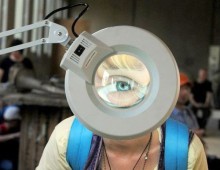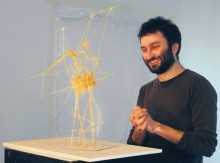IZOlab.org is the website of Ukraine’s first fab lab in Donetsk. Here one can virtually make everything out of nothing, including the building of homes [using the concept developed by MIT Center for Bits and Atoms]. There are more than a hundred of such fab labs across the world, mostly in Holland, Africa, US, and India.
Kostiantyn Leonenko has been in charge of IZOlab for the past two years. This fab lab has organized public lectures and workshops where people could make sculptures using macaroni and Arduino [open-source electronics prototyping platforms based on flexible, easy-to-use hardware and software]. They are using a laser engraver/cutter, 3D-printer, and Arduino microcontrollers. Leonenko is convinced that the main thing is one’s desire and self-education, that then one can create whatever one wants. Technology and engineering are among Leonenko’s fortes. He is the founding father of the local Old Records Fun Club and the Isolation Foundation. His academic background boasts university technology degrees in Donetsk and in Holland. The man was interested in music conservatory acoustics; for a while he helped European artists with their projects. Above all, he sees creative digital potential in Donetsk. He is happy to be the founder of Ukraine’s first fab lab in Donetsk. Uppermost on his agenda now is making IZOlab a self-sufficient entity, considering that there are many examples across the world.
When asked about his 3D printer, Leonenko said his printer was no competition for mass production, adding: “There are lots of things you won’t find in our shopping centers, ranging form the good old case for your glasses to artificial legs. In a word, this is a one-on-one line of business. This business makes sense only when you have a unique product of your own. More often than not, such products are made by those who need such products. For example, those ‘upstairs’ in Indonesia ordered the manufacturing of artificial legs. I don’t know why, but this product was in short supply on the domestic market. Anyway, instead of consulting experts, the way we’d have done here, they simply started teaching the cripples how to make an ideal prosthesis. Those who had mastered the technique would make ideal engineers, because they would know what has to be done and how.”
Does this take special knowledge?
“Any engineer is a bit lazy at heart, but s/he must have basic technical training. Building contact between man and machine is a top priority these days – and I believe this priority will reach the top of the agenda. Today, technical knowledge – I mean one’s ability to create things/facilities one needs in the first place, things you can buy at a reasonable price, simple things you need on a daily basis – comes first. Previously, rank-and-file engineers came up with sets of tools only they knew how to use, because they’d made them. Today, such products are made available en masse, with foolproof instructions. The same is true of the programming language. Previously it was zero-one-zero, now there are lots of such languages that mostly look like English. Each programmer can write a program without having been professionally taught to do so. All this programmer must know is how to properly structure his/her project.”
THERE IS A BIG DIFFERENCE BETWEEN THE ENGINEER UNDER THE SOVIETS AND TODAY
People without any technical training have taken an interest in the exact sciences, trying to combine art and technology, literature and technology, philosophy and technology, and so on. And this with our higher schools in the field of technology suffering from a lack of entrants. How would you explain this situation?
“I think this popularity is best explained by the fact that such technical skills are obvious, easy to learn, and understandable. We all use PCs; we learn [on the Internet] that a certain person wrote a certain program, that someone else came up with a project and became a millionaire. Such online news tend to prompt enterprising users to come up with even better ideas. On the other hand, there are all those online games where you can gamble and take the risk, instead of sitting in your small office, struggling to solve problems sent from ‘upstairs.’ A demotivational poster is a good example. Here one can write that yes, I am an adult, a self-made well-to-do man, but I need a toy chopper set complete with remote control.
“What makes this profession unpopular is, most likely, the engineer’s public image; it is practically the same it was under the Soviets. Even now an engineer is regarded as a backwater technician. Most of our younger generation prefer to major in banking, when enrolled in a prestigious institution of higher learning, rather than consider options. All this relates to our social problems. I remember spotting Google’s project entitled ‘Rock Star Engineers’ where the owners of some engineering products were portrayed as members of The Rolling Stones. A good example of the right kind of promotion strategy, considering that there is a big difference between the engineer under the Soviets and today. At that time, the subject was treated very seriously, with no fan club strings attached. Our IZOlab [equivalent of AARP Foundation] shows how non-technical people can become technical. Image building and attracting interest to technical training are among the fab labs’ priorities. These days technical skills are increasingly in market demand. You can be an armchair physicist or engineer and use your PC to make all kinds of projects while playing online games, sharing your experience and receiving fresh ideas from your online partners. As fresh topics appear on your screen, you can study and develop them; you can come up with new formulas, with solutions to some of the existing complicated problems – and you are constantly aware of your counterparts’ professional interest; you can share knowledge and desire.”
SELF-EDUCATION: FAB LAB’S TOP PRIORITY
Is your fab lab popular in Donetsk?
“Our macaroni project turned out to be very popular, so much so we had to fold up our workshop seminars. Our top priority now is to expand production. We want to introduce a different format, including the weekly ‘Hi, Laser’ project. Our website is open free of charge twice a week, so anyone can access it and offer his/her inventions. We’ll have case and point workshops, but the self-education, access-ask-and-learn approach remains uppermost on our agenda. Our visitors usually have ideas and want us to implement them, but that’s not our policy. We want to maintain a fab lab with people who want and can solve their problems their own way, the way anyone can do so. Among our recent visitors was a maxillofacial surgeon whose main professional interest was in the most vulnerable social stratum, junkies. These addicts usually miss half their teeth because of their lifestyle, and they can’t afford any sort of professional treatment. Our visitor had found such a patient, had his teeth MRI-scanned, emailed a picture, then started a series of dental surgeries to repair the jaw, filling in the gaps. Phase one was to make a platinum ‘imprint’ of the teeth. Phase two would be making false teeth. Unaided by a 3D printer, this process took a long time and cost a lot.
“Our other task is to unite people versed in various fields, to help them combine efforts and share knowledge and experience.”
You have a big library, including issues of the Nauka i zhizn [Soviet ‘Science and Life’ popular journal]. Do you regard your archives as topical nowadays?
“I bought all those Nauka i zhizn issues when visiting a flea market in Odesa. I had long considered the idea of having a research hardcopy library of my own, and once I spotted an ad on the Internet. You can find useful data on practically each page of Nauka i zhizn, including tests and projects that were carried out in Soviet [NKVD/KGB-protected] labs; some of their findings can be used today. I mean, you can leaf through the pages and find useful information.”
Does your professional training as a musician help you along the technical lines?
“Yes, it does, very much so, although my conservatory diploma is actually the reason why I took up music; I wanted to study the ways sound works, how one could create that kind of sound and control it. Needless to say, that kind of training has never been in market demand, but I learned to make that kind of sound and how to use it, process it; how to use that knowledge to obtain information and thus to be able to invent something. In fact, you can transform anything into a digital image; you can measure your temperature and then make an audio file.”









